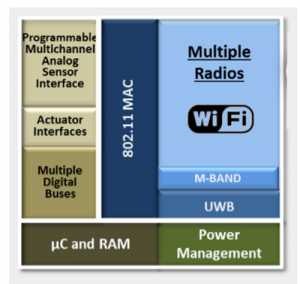By Rick Merritt. This article originally appeared on EE Times, October 4, 2016.
STMicroelectronics Co-Designs Triple-Band SoC
SAN JOSE, Calif. – Startup HMicro Inc. comes out of stealth mode today with a plan to create a high volume market for disposable wireless patches. Its HC1100 SoC, co-developed with STMicroelectronics, uses Wi-Fi and other techniques to link sensors to patient monitors in hospitals.
Hospitals buy as many as six billion wired electrocardiogram (ECG) sensors every year, 4.5 billion of them from two big medical OEMs — 3M and Covidien. The sensors are sold in small volumes for less than $20 when paired with increasingly popular disposable lead wires.
Aiming to deliver ease-of-use and patient mobility, HMicro’s wireless patch will sell for a small premium over the costs of the wired sensors and wires. “The idea is like how Wi-Fi took hold replacing wired Ethernet, but so far no one developed a targeted platform for this medical application,” said chief executive Surendar Magar who founded Athena Semiconductors, a Wi-Fi and TV-tuner startup sold to Broadcom in 2005 for $21 million.
Researchers and startups have been exploring wireless patches for several years. Some aim at fitness or specialized uses such as tracking pregnancies or other applications, some using rechargeable patches, he said.
HMicro was formed six years ago by Magar who was then an entrepreneur in residence at Mohr Davidow Ventures. It started working with STMicro in 2011 on its concept for an SoC.
The startup has taken about $30 million in investments from partners and VCs to date. Its first chip is in production and partners will be announced later this year including a company who will make the patches in Korea and OEMs who will sell them to hospitals.

(The HC1100 is used in patches and receiver dongles on patient monitors.)
The HC1100 is the first in a planned family of SoCs from HMicro. It includes ECG and blood oxygen sensors, a dual-core ARM Cortex-M0 processor and radios for 802.11b Wi-Fi, a 2.36-2.4GHz medical band and 3.1-10 GHz 802.15.6 ultrawideband.
“Wi-Fi alone does not solve the problem [of, for example] having 50 people in an emergency room trying to get a wired-rate link,” said Magar.
The ultrawideband and medical-band links act as backups for carrying Wi-Fi protocols when congestion is heavy. The radios are limited to the specific use case and share resources as much as possible to keep the design simple.
The unique approach means users must also buy and plug into their patient monitors a dongle with to support all three networks. The dongle includes both an HC1100 and a second ultrawideband receiver chip.
The startup’s implementation of Wi-Fi also is unique, limited to the 150 milliAmp maximum sustained power draw possible from the standard zinc-air coin-cell battery on the patch. Typically Wi-Fi draws about 200 milliAmps. “We had to create radios from the ground up,” Magar said.
HMicro rejected Bluetooth for two reasons. It was less energy efficient in nanojoules/bit at the applications target data rates of a few hundred Kbits/second. In addition, the Bluetooth pairing process “would be a serious problem,” especially when moving patients between separate monitors in a hospital room, on a gurney and in an operating room, he said.
ST makes the SoCs in a 90nm CMOS RF process. Future versions of the patch may integrate a variety of sensors including accelerometers, temperature and pressure sensors and microphones.
The patch could fuse data from multiple sensors with mics both for listening to the heart and recording a patient’s notes. Longer term, the startup foresees linking the patches to smartphones and applying versions of its technology to other medical and industrial uses.
